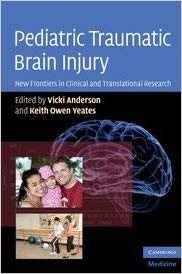 Editors: Vicki Anderson and Keith Owen Yeates
Editors: Vicki Anderson and Keith Owen Yeates
Publisher: Cambridge University Press – 235 pages
Book Review by: Nano Khilnani
The editors write that traumatic brain injury (TBI) among children and adolescents is “a major public health problem,” stating that it is one of every 20 cases presented in the emergency departments at children’s hospitals around the United States, and it is more common than instances of burns and poisoning.
Serious injuries to the brains of children can cause interruptions to their mental and physical development and growth, but a majority of the injuries to children and adolescents are mild, with few long-term consequences,
Those who do sustain serious or severe TBI however, will experience on a long-term basis, adverse cognitive, developmental, educational, emotional, functional, and social consequences, as well as physical (including movement) challenges.
Twenty-four specialists in the various neurosciences particularly as they pertain to traumatic brain injury in children; adolescents, and adults; as well areas such as bioengineering, biology, physical medicine and rehabilitation, psychiatry, psychology, radiology, and resuscitation, from all over the United States, and four other countries – Australia, Canada, Norway, and Sweden – authored the 12 chapters of this book. We list their titles below to provide you a brief overview:
Introduction
- Biomechanics of pediatric traumatic brain injury (TBI)
- Neurobiology of TBI sustained during development
- Using serum biomarkers to diagnose, assess, treat, and predict outcome after pediatric TBI
- Clinical trials for pediatric TBI
- Advanced neuroimaging techniques in children with TBI
- Neurobehavioral outcomes of pediatric mild TBI
- Very long-term neuropsychological and behavioral consequences of mild and complictated mild TBI: increased impact of pediatric versus adult TBI
- Neurobehaviotal outcomes of pediatric TBI
- Neuropsychological rehabilitation in children with traumatic brain injuries
- Psychosocial interventions
- Pediatric TBI: challenges for treatment and rehabilitation
- Integrating multidisciplinary research and translation from the laboratory to the clinic
The editors and chapter authors of this book who have been treating patients in various ranges of age have learned the following, and we quote the editors’ exact words so the reader will know precisely what has been learned in TBI cases spanning several decades
- Injuries to the developing brain cannot be understood or treated in exactly the same manner as those occurring in adulthood
- Unique developmental and contextual issues need to be taken into account at all stages of recovery and treatment in children
- A separate knowledge base is needed in pediatric TBI
- Until recently the editors’ and authors’ understanding of recovery and outcomes in pediatric has lagged behind that of adults
- Recent research in pediatric TBI now has more solid foundations
- A number of principles in pediatric TBI have been established some consistent with adult literature, such as the predictive value of injury severity
To give you an idea of the sort of topics discussed in the book’s chapters, let us give you an outline of the material in chapter 5 entitled Advanced neuroimaging techniques in children with traumatic brain injury, authored by Stephen Ashwal, Karen A. Tong, Andre Obernaus, and Barbara Holshauser.
They present various scans of brains of children obtained with different imaging modalities, along with photo captions and detailed discussions:
- Introduction
- Comparison of CT and MRI for outcome prediction
- Susceptibility weighted imaging
- Magnetic resonance spectroscopy (MRS)
- Diffusion weighted imaging
- Diffusion tensor imaging
- Conclusions
At the end of this chapter the authors point out that more recently developed imaging techniques applied to evaluate various kinds of injury to children’s brains provide “new understanding” of the responses to such injuries as the brains are in various developmental stages.
The images also show correlation between injuries in different parts of the brains and their neuropsychological effects on the children. They express optimism that additional knowledge gained through these advanced imaging modes will further add to their understanding, and as a consequence, result in better outcomes in their patients.
Indeed, this book is a pioneering effort of all those individuals who were involved in developing and presenting it as finished product. But it represents a relatively newer, rapidly-growing, and exciting medical specialty holding a lot of promise!
Editors:
Vicki Anderson is Professor of Pediatrics and Psychology at the University of Melbourne, Director of Critical Care and Neurosciences Research at Murdoch Children’s Research Institute and Director of Psychology at Royal Children’s Hospital in Melbourne, Australia.
Keith Owen Yeates is Professor of Pediatrics, Psychology, and Psychiatry at Ohio State University. He is also Director of the Center for Biobehavioral Health, Research Institute, and Chief of the Department of Psychology at Nationwide Children’s Hospital in Columbus, Ohio.






